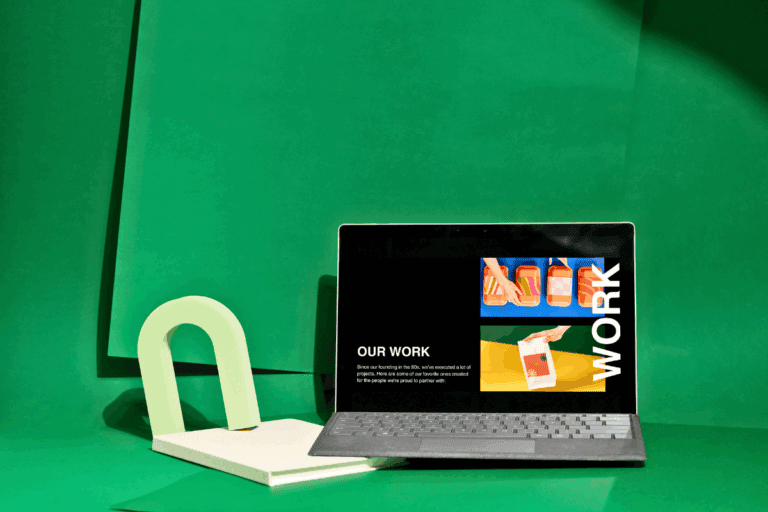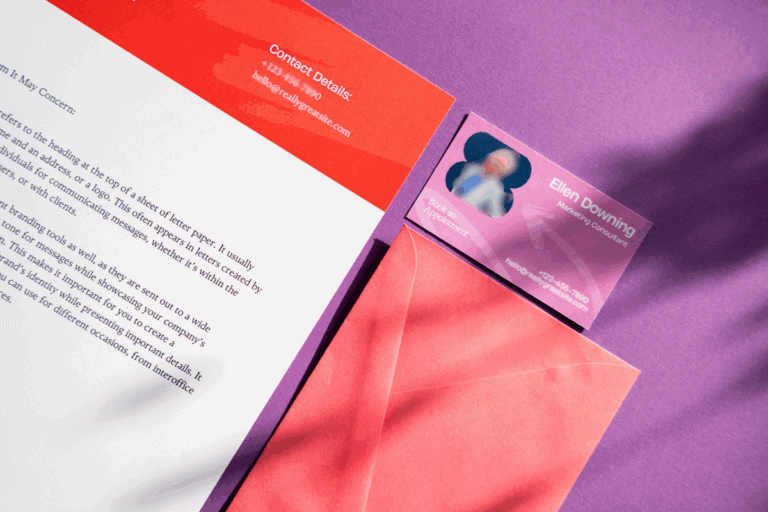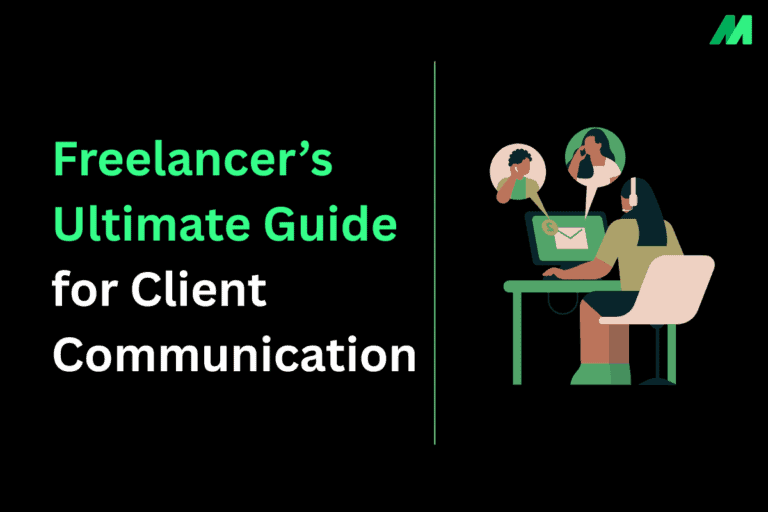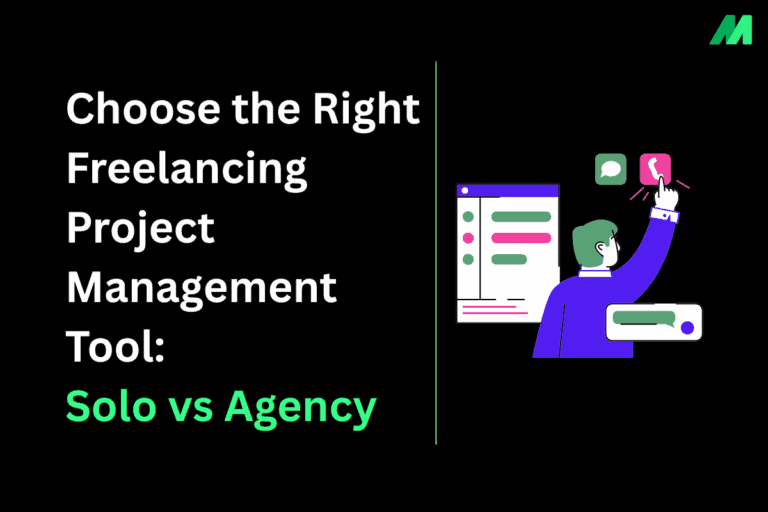Starting freelancing but worried about having no client work to showcase? Don’t panic. You can still create a powerful freelance portfolio with no clients. This guide shows step‑by‑step methods, tips, and examples to attract opportunities and build credibility from scratch.
How to Build a Freelance Portfolio with No Clients?
1. Decide the Purpose of Your Portfolio
Understand why you need a portfolio: to showcase skills, attract clients, and build credibility. This is essential, especially for freelancers in creative fields like writing, design, development, or marketing.
How to do it?
Know what you want to get out of your portfolio. It shows what you’ve done and what you can do. This gives people proof of how you think and solve problems. It also builds trust and sets you apart from others in your field.
Consider who will view your portfolio, like clients or companies. Knowing what they want will allow you to design your portfolio better.
Pick what goes into your portfolio based on what you want to achieve. If you want clients, show your best work. To build trust, add case studies and recommendations. If you’re focusing on branding, show your approach and values.
Know what success looks like for you. Examples include getting interview requests, job offers, growing your network, or gaining followers. These show your portfolio is working.
Tutorial/Guide:
- Video: “How to Define Your Portfolio Purpose” (YouTube search)
- Article: How To Create an Online Portfolio: A Step-by-Step Guide
2. Define Your Niche and Target Audience
Choose a specific freelance niche to specialize in, such as graphic design, content writing, web development, etc. Research your ideal clients to tailor the portfolio to their needs and preferences.
Understand What You Are Good At and What You Like: Consider what skills you possess. For instance: writing, graphic design, social media, and website development. Also, think about what type of work excites you or motivates you. It is more likely that you will perform better if you have a career in a field that you love!
Look Around What Are People Paying For: Review sites like Upwork, Fiverr, or Freelancer, to see what freelance opportunities are available. Observe what jobs have a lot of clients and good payment in relation to your skills.
Imagine What Your Perfect Client Should Be: Identify the types of clients you want to work with. Small businesses, bloggers, large corporations? What problems can you help them solve? Like building a website, writing blog posts, or creating logos. Understanding these details will help you construct your portfolio to show the work of an ideal client.
Check Out Your Competition: Search for other freelancers doing what you want to do. Review their portfolios and compare what they offer. Think of how you can be different or better.
Start Small and Be Open to Change: Initially, focus on just one area. In time, as your experience increases, you can branch out and add new skills and clients. It is also perfectly acceptable to change your niche over the course of your career as you learn what you enjoy most!
Helpful Tutorials and Guides to Get You Started:
- Video: “How to Find Your Freelance Niche in 5 Minutes”
(Search YouTube for this title; many simple tutorials explain with examples.) - Beginner’s Guide: “Freelance Niche for Beginners”
Websites like Fiverr Learn and Upwork Community have easy articles. - Step-by-step blog: How to Choose Your Freelance Niche
(This guide explains picking niches with examples for creatives)
3. Create Sample Work or Mock Projects
Since there are no real clients yet, create work samples that mimic real projects. These can be personal projects, speculative pieces for fictional clients, volunteer work, or redesigns of existing projects. Curate 5-7 high-quality pieces to showcase your skills effectively.
How to?
Step 1: Pick Projects That Show Your Skills: First step is to identify what freelance project(s) you’d like to work on: writing articles, designing a logo, building websites, etc. Next, come up with 3-5 project ideas that will allow you to hone these skills and present your best work.
Step 2: Create Fake or Personal Projects: You may create projects for imagined clients or businesses, for example, design a logo for a fake coffee shop. You can also repeat or build off of an existing project you liked. You can also include personal projects, such as a blog or portfolio site, or a mobile app.
Step 3: Focus on Quality and Detail: For each mock project, act like it is a real client, and think carefully about colors, fonts, writing style, and layout structure. Your mock project should include useful details about the client’s goals, the client’s problems, and how your project grows from or addresses these problems.
Step 4: Show Your Process: You can include sketches, drafts, or steps you took to complete your project, and tell why you made specific design or writing choices. This demonstrates to clients your skills and thinking, beyond just the final product.
Step 5: Ask for Feedback: Share your work samples with your friends, or online groups for freelancers, or ask for feedback from mentors. Then use that feedback or their ideas to enhance your projects, before each project becomes part of your portfolio.
Helpful Tutorials and Guides:
- Video Tutorial: “How to Create a Freelance Portfolio with No Clients”
(Search YouTube for similar titles for easy step-by-step videos) - Beginner’s Guide: “Creating Sample Projects for Your Portfolio”
Blogs on platforms like Medium, Pixpa, or Upwork often have guides with examples. - Guide example: How to Build a Freelance Portfolio Without Paid Clients
(This blog explains how to create and use sample work effectively.)
4. Write Context and Story for Each Project

Also, include the backstory, and explain the problem you solved, the creative process you took, and the result or benefit. This story format builds credibility and enables your clients to visualize your process of problem-solving.
Start with introducing who the project is for and if it was for an individual or invented client. Clearly explain what the project was about. For example, designing a home page or writing social media posts. This should be clear and simple.
Explain the Problem or Goal. What the client wanted to do, and why it was important to them. Describe any obstacles you faced and how you resolved them.
Describe the process you went through to complete it. Mention your ideas, tools, or strategies. This is to show your skills and processes.
Share the Results: Talk about what happened after your project was finished. Include outcomes, if any, like increased site visits, happy clients, or nice-looking designs. If no outcomes yet (in mock projects), please talk about expected advantages.
Keep It Personal and Professional by using a friendly/professional tone when explaining what you did. Be honest about what you did and your role in the project. Also, comment on any lessons learned, or what part of the project you liked doing the most.
Helpful Tutorials and Guides:
- Video: “How to Write Case Studies for Your Portfolio”
(Look for beginner-friendly videos on YouTube for storytelling tips) - Article: How to Write Project Descriptions That Attract Clients
(Explains how to make project stories engaging and clear) - Blog: Writing Context for Your Freelance Portfolio Projects
(Offers simple language examples for beginners)
5. Build a Professional Portfolio Website
Choose a platform to host your portfolio, such as WordPress, Wix, Behance, or specialized portfolio builders. Use a clean, user-friendly design and ensure the site is responsive and easy to navigate. Create dedicated pages such as Projects, About, and Contact.
How to?
Choose a Website Platform that is easy to build, like Wix, WordPress, Squarespace, Behance, or Pixpa. These platforms are made for creatives, provide templates you can customize, and have drag-and-drop editors.
Select a Clean and Simple Design. Look for a professional and easy-to-navigate design. Make sure to use the same fonts and colors on the site, and keep it simple so your viewer can focus on your portfolio.
Create Important Pages. Home page (introduction), Portfolio/ Projects page (showcase your work with images and a story), About Me page (tasteful and appropriate, your path, your skills), and your Contact page (email, social media, or a contact form).
Add Your Work Samples. Be sure to showcase your best work. Clearly define the projects/titles, provide context and purpose for the work, and include your best visuals or videos with all the right resolutions.
Make Your Website Mobile-Friendly. Preview the site on mobile since most builders will automatically optimize the site for mobile, too.
Use SEO Basics to Get Found. Keep the SEO very basic. Apply freelance-related words in your titles, apply some freelance-related words in your project description, and make sure that you connect and follow Google Search Console so you can be found.
Publish and Share Your Website. Before launching to the world, always check your links and images. Then share and promote the new website through your social media platforms, email signatures, and freelance platforms you are part of. Remember to always update your website with new/relevant projects regularly so that you remain relevant.
Helpful Tutorials and Guides:
- Video: “Build Your Freelance Portfolio Website Step-by-Step”
(Search YouTube for beginner tutorials on Wix or WordPress portfolio sites) - Step-by-Step Guide: How to Create an Online Portfolio (Beginners)
(Clear explanations with examples and tips) - Beginner-Friendly Blog: How to Build a Freelance Portfolio Website
(Focuses on freelancers starting from zero clients)
6. Craft a Compelling About Page
Share your story, skills, work ethic, and professional photo. This helps to humanize your portfolio and build your trust with prospective clients.
How to?
- Start with Your Name & Service: Who you are and what you do (e.g., “I’m [Name], a freelance content writer”). Keep it professional yet friendly.
- Share Skills & Experience: Highlight your core skills, tools you use, and project types. If new, show passion and eagerness to learn.
- Tell Your Story: Briefly explain why you chose freelancing and what makes your journey unique or inspiring.
- Highlight Work Style: Mention your values, how you work, and what clients can expect from you. Builds trust and credibility.
- Add a Personal Touch: Use a professional photo, and if you like, share a short hobby or fun fact for relatability.
- End with a Call to Action (CTA): Invite clients to view your portfolio, connect with you, or hire you. Be clear and direct.
What Is a Call to Action (CTA)?
It’s a phrase, or button, with action words such as “Contact Me,” “Hire Me,” “View My Work,” or “Get a Free Quote.” The point is to get visitors to act immediately, which gets them closer to being your client. CTAs will make your portfolio more engaging and help visitors clearly understand their next step.
Helpful Tutorials and Resources on CTAs
- Article: 30 Powerful Call to Action Examples (Includes examples & tips)
- Guide: How to Write Great Calls to Action
- Video: Search YouTube for “Call to Action for Freelance Portfolio” Find beginner-friendly walkthroughs and examples.
- Video Tutorial: “How to Write an About Me Page That Sells”
(Look for beginner-friendly videos on YouTube) - Article: How to Create a Great Freelancer About Page
(Explains what to include with sample phrases) - Step-by-Step Guide: About Page Tips for Freelancers
(Simple language guide focused on freelancing)
7. Include Testimonials or Social Proof
If you don’t have client testimonials, you can add endorsements from peers, mentors, or volunteer clients. Social proof helps generate trust and validates your skills. Essentially, testimonials consist of quotations or feedback from past clients or anyone who could attest to your skills. Social proof also includes endorsements, stories, and reviews from anyone or anything that documents or reports that others trust and recommend you.
Ask for Testimonials from Anyone You’ve Worked With: If you don’t have any paid clients yet, ask your friends, classmates, teachers, or volunteer clients who are familiar with your work to write a couple of sentences and add them to your portfolio on your work with them.
Use Testimonials from Spec or Volunteer Projects: For spec projects, you can add notes with any feedback you received during the process (even if it wasn’t formal). All of these projects demonstrate that you care about your work and get positive reactions.
Where to Place Testimonials?
Add a Testimonials section/page on your portfolio site. You could even add short quotes on your Homepage or About page. If they let you, use photos or names – it enhances the believability of the testimonials.
Include Social Proof from Online Profiles. Attach or embed any reviews from freelancing sites such as Upwork or Fiverr whenever you get them.
How to Link or Embed Reviews?
- Upwork: How to Share Your Profile and Reviews (Official Upwork help center)
- Fiverr: Embedding Profile Link and Reviews (Search Fiverr help or tutorials)
- Video Tutorial: “How to Add Upwork Reviews to Your Portfolio” (YouTube beginner guides show practical steps)
- Blog: Using Client Reviews to Boost Your Freelance Portfolio
- Video: “How to Get and Use Testimonials for Your Freelance Portfolio”
(Search YouTube for easy-to-follow guides with examples) - Article: How to Collect and Display Testimonials
(Simple, beginner-friendly tips on asking and using testimonials effectively) - Guide: Social Proof Tips for Freelancers Starting Out
(How to build credibility without paid clients using social proof)
8. Optimize for SEO and User Experience
Help your search rankings by using relevant keywords within your project titles and descriptions. Your folder is easier for visitors to use if the navigation is intuitive and has clear action steps that will help potential clients be inclined to contact you.
SEO is Search Engine Optimization. SEO is the process of making your website more discoverable in search engines like Google when people are searching for services, such as freelance writing or graphic design. When a user types words (keywords) into Google, SEO will help your portfolio website rank higher in their search results. The better your rank, the more visitors you receive (potential clients)! Good SEO ensures both clients and search engines can understand your site.
Helpful Beginner Tutorials About SEO:
- Video: “SEO Explained for Beginners”, “SEO for Beginners: Optimize Your Portfolio Website” (Search on YouTube for simple, visual explanations); “How to Set Up Google Search Console for Beginners” (YouTube beginner tutorials); “How to Add Google Analytics to Your Website” (YouTube beginner tutorials)
- Guide: SEO Basics for Freelancers; Google Search Console Starter Guide ; Google Analytics Setup
- Article: What Is SEO and How It Works (Simple beginner-friendly guide)
9. Promote Your Portfolio Actively
To gain visibility, promote your portfolio on several channels, such as social media and freelance platforms. Reach out to potential clients. Update your portfolio with recent work.
- Post your portfolio link on platforms like LinkedIn, Twitter, Facebook, and Instagram.
- Join relevant groups or communities where your ideal clients hang out.
- Regularly share updates like new projects, tips, or behind-the-scenes work.
- Create profiles on platforms like Upwork, Fiverr, or Freelancer.
- Add your portfolio link to these profiles. (How to? Look at the table below.)
- Apply for jobs that match your skills and send personalized proposals including portfolio samples.
You can also connect with other freelancers, clients, or professionals in your industry through LinkedIn or local meetups. Attend workshops, webinars, or conferences where you can talk about your skills and share your portfolio. Ask friends and family to share your portfolio link.
Create articles linked to your skills and post them on your blog or on Medium. Contact websites and propose guest posts that link to your portfolio.

Add Your Portfolio Link Everywhere
- Your email signature.
- Your business cards.
- Any online profiles or forums where you participate.
If you secure clients, ask them to share your portfolio within their networks. Word-of-mouth has a strong impact on starting a freelance business.
Helpful Tutorials and Guides:
- Video: “How to Promote Your Freelance Portfolio for Beginners”
(Search YouTube for step-by-step promotion strategies) - Article: How to Market Your Freelance Business
(Simple marketing tips for new freelancers) - Guide: Promote Your Freelance Portfolio
(Detailed beginner-friendly promotion advice)
10. Continuously Improve and Update
Regularly refresh your portfolio with new samples, updated skills, and enhanced design to keep it relevant and appealing.
- Add New Projects: When you finish a freelance job or make something new, put it in your portfolio.
- Refine Existing Work: Make old projects better with good descriptions, images, or results as you get better or receive feedback.
- Improve Design and Usability: Over time, make your website easier to use, load quickly, and look nicer.
- Reflect New Skills: If you learn how to use new tools or jobs, show them off in your portfolio.
- Adjust to Market Trends: Change your portfolio to show what clients want, like new styles or jobs.
How to Best Improve and Update Your Portfolio
- Update it every one to three months. Add what you’ve been working on, and polish up older projects as needed.
- Get some outside opinions/feedback, and then use their advice to make things better.
- Continue to learn and grow, and then feature these new abilities in your updated projects.
- Take out anything from your portfolio that doesn’t show your best work or is just plain old.
- By using the newest tools available, keep your website current. Make sure it works well on phones and tablets, and address any problems or broken links ASAP.
Helpful Tutorials and Guides:
- Video: “How to Keep Your Freelance Portfolio Updated” (Search on YouTube for beginner-friendly tips)
- Article: Maintaining and Improving Your Portfolio
- Guide: Why and How to Update Your Portfolio Regularly
Having no clients can make freelance portfolios seem intimidating to create. However, it can be done, without clients, if you take some specific steps. The most important of which is to define your purpose, whereafter you should develop quality sample work, and market that portfolio. Once you create a coherent portfolio and have stuck to these steps, you should be primed to win real projects. Don’t forget you need to keep evolving your portfolio to reflect how your unique abilities and professionalism have grown and improved. Start now, be consistent and nail how your freelance career began from scratch with confident growth moving forward!




